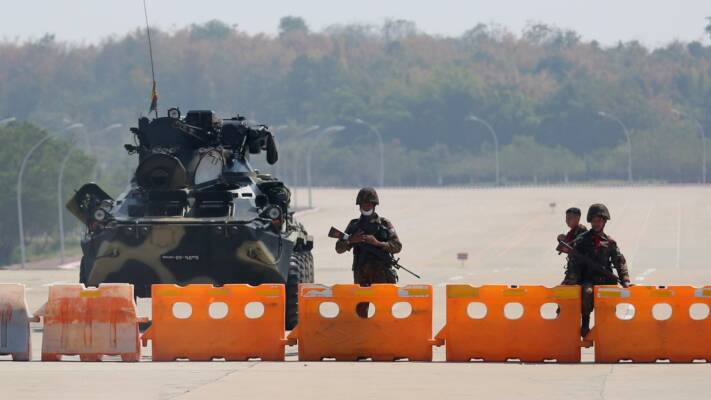
Myanmar has once again gone back to rule by military junta, after 10 years of experiment with democracy. The coup took place on 1 February 2021, just a day prior to the swearing in of newly elected members of Parliament. The National League for Democracy (NLD) led by Aung San Suu Kyi had won a majority in the November 2020 elections.
In a sudden move, President U Win Myint and State Counsellor Aung San Suu Kyi, along with several ministers of the government, were detained by the military junta. Aung San Suu Kyi has been charged with the offence of possessing illegally imported walkie-talkie radio sets. It is the most frivolous charge of corruption and declaration of emergency for one year by the Commander-in-Chief of Defence Services of Myanmar, General Min Aung Hlaing.
Chinese Hand in the Coup!
The cause for the military takeover may lie elsewhere. Most analysts see the Chinese hand in it. The Chinese government has given a muted reaction, while its official news agency Xinhua calls it a “Cabinet Reshuffle”. China has also blunted a UN Security Council move to discuss this military coup in Myanmar. Therefore the Chinese hand seems to be obvious.
It is a known fact that for long China has been eyeing an access to the Indian Ocean through either the Bay of Bengal or the Persian Gulf. Its Belt and Road Initiative (BRI) or the One Belt, One Road (OBOR) are aimed primarily at this. To do so, China had first embarked on the CPEC (China Pakistan Economic Corridor) to Gwadar port on the Persian Gulf in the Balochistan province of Pakistan. However, the $62 billion CPEC project seems to have run aground due to some other reasons. No need to dwell upon them here.
The second option was to seek access to Indian Ocean through the Bay of Bengal, which is masked under its CMEC (China Myanmar Economic Corridor), a lollipop of economic package to lure Myanmar. The land route from Bay of Bengal allows China to avoid the choke points at the Malacca Strait and South China Sea for its trade with the rest of the world and oil/gas supplies from the Persian Gulf. However, this option is also hindered by the Rohingya-dominated Rakhine province, through which pipelines and the BRI project have to pass through.
Significance of Bay of Bengal for China
Why is China showing such deep interests in the Bay of Bengal? It must be noted that 80-90% of China’s petroleum products are imported from the Middle East. This is transported over a distance of 12,000 km through the Indian Ocean via choke points at the Malacca Strait and the South China Sea. They say China has only 55-60 days of reserve petroleum products. Thus, it cannot sustain an intense military conflict for more than 60 days. With sea lanes choked by the US, Japan, Australia and even India, it can run out of steam to sustain a war effort that might involve the US and the West.
China wants to avoid this interruption in oil supply. Thus, it has been looking for alternatives to sea routes for oil and gas supply. The BRI or OBOR are actually part of these strategic plans of China. Significant, too, is the point that China gets an opportunity to sandwich India, her biggest hurdle towards global ambitions, between Myanmar and Pakistan. The CPEC and the CMEC are therefore force multipliers for China’s ‘String of Pearls’ policy to contain and roll back Indian influence into her borders.
The July 2017 Doklam crisis was a probing attempt by China to see India’s reaction. With the Bay of Bengal in mind, it was trying to create the shortest land route through Chumbi Valley-Siliguri Corridor-Bangladesh. It might attempt this again at some favourable time in the future. For now, it also looks at the CMEC as a suitable alternative. India cannot ignore Chinese forays into the Bay of Bengal through the CMEC or the CPEC
Myanmar In Chinese Scheme Of Things!
Lying at the junction of South Asia and SouthEast Asia, Myanmar enjoys an important strategic position between the Indian Ocean and Yunnan Province of China. It gives an easy entry to China into the Bay of Bengal and Indian Ocean. What is more concerning to India was the close proximity of the Myanmar coast to India’s strategically important Andaman & Nicobar group of islands. In fact, the northernmost island from this group is just 15 km south of Coco Island, which has been leased to China by Myanmar.
In 2018, Myanmar had become an important cog in the BRI after it had signed a 15-point memorandum of understanding (MoU) with the Chinese government. This MoU included a whole gamut of national activities. It was a virtual penetration into Myanmar’s national life. This is a clever ploy of China everywhere to lure and then subjugate. The MoU pertained to collaboration in several sectors such as infrastructure development, finance, agriculture, transport, telecommunications, technology and research etc. China had proposed 18 projects under the BRI but Myanmar had only publicised nine, which include three Special Economic Zones (SEZs) and the Mandalay to Muse railway line.
In December 2019, China’s foreign minister Wang Yi visited Myanmar and proposed the China Myanmar Economic Corridor (CMEC) as part of the BRI. The Myanmar establishment had reacted very favourably. Wang Yi insisted that infrastructure development was the key to CMEC and it must be expedited. He further emphasised that the Kyaukphyu SEZ was key to the China-Myanmar Border Economic Cooperation Zone. The Kyaukphyu port in Bay of Bengal was central to this project. The SEZ is a 1,700 km-long corridor that would connect Kunming, capital of Yunnan province of China, with Mandalay, Yangon, capital of Myanmar, and Kyaukphyu in Rakhine state of Myanmar.
This is the province dominated by Rohingya Muslims and the cause of their enforced exodus. Rohingya Insurgency is a big threat to the CMEC. The problem had begun in 2012, when China started facing issues regarding its two pipelines (oil and gas) through the Rakhine Province. The security of the pipeline was at risk due to the Rohingya insurgency. Though the democratic government of Aung San Suu Kyi had in the past supported military action against Rohingyas, it discouraged their displacement from Rakhine province. This had upset China’s ball game.

As pointed out earlier, China had taken Coco Island in the Bay of Bengal on lease for 40 years from Myanmar in 1994. This island lies some 15 km north east of the northernmost island of Andaman & Nicobar group of Islands of India. China was developing military facilities there, reportedly including an airstrip and signal intelligence. This island lies close to Myanmar’s Kyaukphyu port, which is also leased to China. It is pertinent to know that China has two pipelines, one for gas and another for oil, running from this port to Kunmin in China. Thus, the Bay of Bengal figures in a big way in the strategic interests of China.
China’s other worry is India. The democratic government of Aung San Suu Kyi had been tilting towards India. In October 2020, just a month before elections in Myanmar, India’s Foreign Secretary Harsh Vardhan Shringla and Army Chief General MM Naravane visited Myanmar and met Aung San Suu Kyi and the military authorities. This was an unusual move and it might have alerted China. As it is, China was worried about India’s Kaladan Project.
The $484 million Kaladan Road Project aims to connect the eastern Indian seaport of Kolkata with the Sittwe seaport in Rakhine state of Myanmar by sea. In Myanmar, it will then link Sittwe seaport to Paletwa in Chin state via the Kaladan River boat route, and then from Paletwa by road to Mizoram state in Northeast India. The purpose of this route is to create an alternative road link to the Northeastern (NE) states of India. Its significance rose due to the Doklam face-off with China in July 2017. Should the Siliguri Corridor link to NE states be cut off by a Chinese pincer through Chumbi Valley, the Kaladan project provides an alternative. China wants to scuttle this and the Myanmar military leadership may play the ball for a few fistfuls of dollars.
Impact On India
From a strategic point of view, India has many things to worry about if China makes a large-scale access by land route to the Bay of Bengal. It would not only cut off its entire North East region but would be more damaging and disturbing from the national security point of view as under:
a) India’s Missile Testing Range (MTR) in the Wheeler Island, some 10 km off the coast of Odisha, would come under the direct threat of China. It lies some 150 Km east of Cuttack.
b) India’s ship building and submarine facility in Visakhapatnam or Vizag would become a target of China. India’s nuclear submarine Arihant was built here.
c) Indian Space Research Organisation (ISRO) at Sriharikota can be effectively targeted from Coco Island. This can render a serious blow to Indian space research and the “Eyes in the Sky” programme.
d) The security of India’s Andaman & Nicobar Islands becomes untenable. India has 572 small-and medium-sized islands here. It controls the entry to not only the Malacca Strait but can also regulate the East-West traffic in the Indian Ocean.
e) Indian states along her eastern coast, from Bengal to Tamil Naidu through Odisha and Andhra Pradesh become vulnerable to Chinese-sponsored insurgency. Thus China can effectively carry out its strategic plans to break up India into 20-30 states, as a Chinese scholar had expounded the thesis in an article in the Global Times in 2009. This is a long desired plan of China because it knows India was her final frontier to be conquered before it could lay claim to superpower status and dominate the world.
Finally, do not forget that India’s Kaladan Road project can be scuttled by Chinese influence over Myanmar’s military regime. It will be a big setback for India and could lead to isolation of the NE states, should China manage to gain control of Myanmar’s military. India must seek the return of democracy in Myanmar and use all its influence to send the Myanmar military back to the barracks.
-An ex-NDA and Wellington Staff College graduate, Col Rajinder Singh is a renowned author and security analyst. He has authored four books, two individually and two in collaboration. His best-selling books are Kashmir – A Different Perspective and The ULFA Insurgency. The views expressed are of the author and do not necessarily reflect the views of Raksha Anirveda








